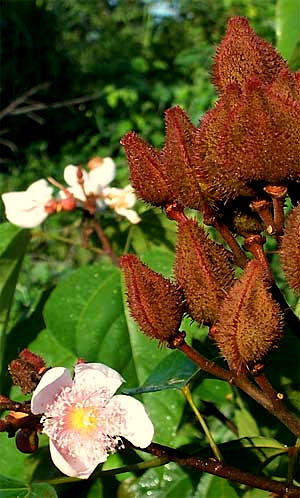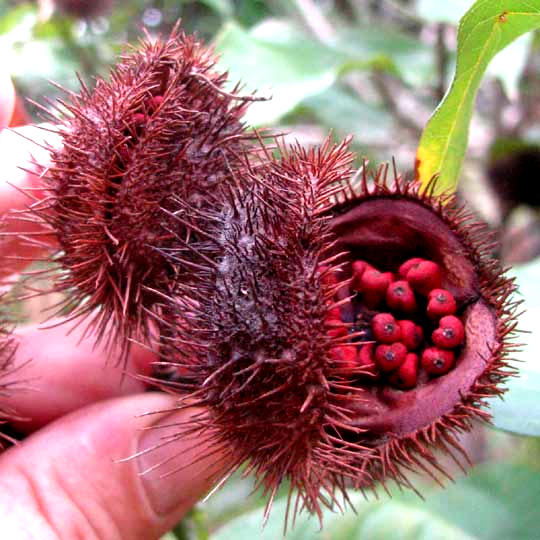Excerpts from Jim Conrad's
Naturalist Newsletter
from the November 6, 2006 Newsletter issued from Genesis Retreat in Ek Balam, central Yucatán, MÉXICO
ACHIOTE

A bush or small tree currently flowering prettily next to people's huts in Ek Balam is a native tropical-American one considered desirable by so many cultures that now it's planted nearly throughout the world's tropics. In Spanish it's known as Achiote and in English as Annato. It's BIXA ORELLANA, of the Bixa Family, sometimes called "The Lipstick Tree Family," and it's shown at the right.
In that picture the reddish, soft-spined fruits next to the two-inch-wide white flower are immature. In a few weeks, however, you'll be able to crack the pods open and see why the tree is sometimes called Lipstick Tree: Inside will be numerous small, fleshy seeds about 1/5th across covered with bright, red-orange pulp. The garish pulp in which the seeds are embedded is wonderful stuff.
First, dye obtained from the pulp is used all over the world for coloring rice, cheeses, soft drinks, oil, butter, and soup. It's used in some regions to dye textiles and in some cultures people dye their hair and bodies with it for cosmetic reasons, and to repel insects and protect them from sunburn. It was used as a warpaint by many native Americans. The seeds are given to bulls to make them aggressive for bullfights and are taken by some indigenous people as an aphrodisiac. You can read about many more uses at http://www.virtualherbarium.org/gl/bixa/bixaorellana.htm.
from the March 25, 2012 Newsletter issued from Hacienda Chichen Resort beside Chichén Itzá Ruins; limestone bedrock; elevation ~39m (~128ft), N20.675°, W88.569°; central Yucatán state, MÉXICO
ACHIOTE FRUITS
Hacienda Chichen's Chef Josué regularly offers guests cooking lessons. When the guests don't speak Spanish, I translate. Therefore, frequently during my time here I've described to visitors how to cook various traditional Maya dishes.
A surprising number of traditional Maya dishes require an orangish-red paste called recado rojo, or "red broth." Even in the little frutaría where I buy my bananas and oranges in Pisté they sell plastic-wrapped blocks of the moist, reddish paste. The paste's ingredients usually include Mexican Oregano, cumin, clove, cinnamon, black pepper, allspice, garlic, salt, and ground-up Achiote seeds. It's the orangish-red Achiote seeds that impart to "red broth" its redness, and contribute much to the broth's special taste.
Achiote seeds are produced in spiny pods of the Achiote shrub or small tree, BIXA ORELLANA, in English often known as Annatto. In every Maya town Achiotes commonly grow around people's homes and along streets. The other day a fruit was opening, about to drop its seeds, so necessary for "red broth." This is shown below:
